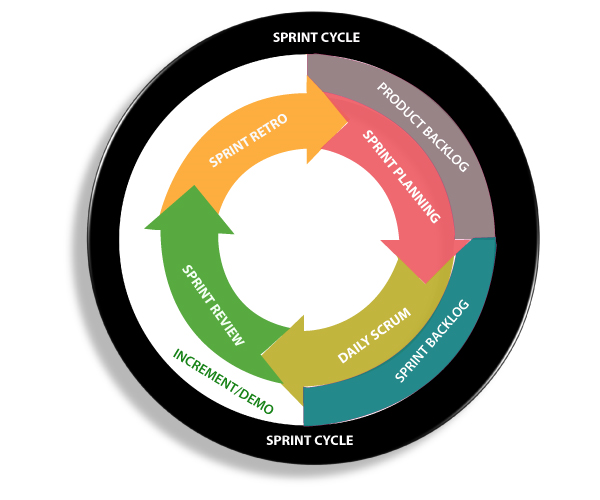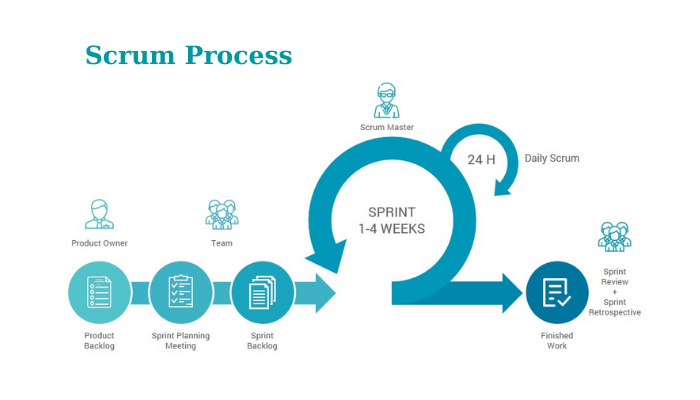What is a Scrum Sprint?

What is a Scrum Sprint? What length should a Scrum sprint take? How do you plan a Scrum Sprint? Each Scrum team is unique, but there is one thing they all have in common: the need to execute successful sprints.
This section will discuss sprint planning and sprint ceremonies. We’ll also explore what happens after the sprint is over. Let’s start with the definition of a Scrum Sprint.
What is Scrum Sprint?
Scrum sprints are time-boxed periods during an ongoing development cycle that focus on a particular set of capabilities or features. Sprints usually last between 1 and 4 weeks. The Scrum team’s primary goal is to deliver a product increment, which is a version that incorporates the features and backlog items that were prioritized and completed during the sprint.
A sprint is a method of breaking down the project into manageable chunks. Each stage is determined by the feedback received and features prioritized during the backlog grooming and the sprint planning.

How many sprints are in a Scrum Project?
There are no “ideal” numbers of sprints for a project. Sprints depend on the scope of your project. While longer projects will naturally have more sprints than shorter ones, a project that is twelve weeks long may require four to six sprints. However, a standard number of springs for a 12-week project might be four to six sprints. These are the stages of the sprint process.
Stages of a Scrum sprint project management
Sprint project management includes many stages, including planning, execution, sprint review, and sprint retrospective. This section will cover the main stages of a Scrum sprint project management stage
This stage is where the Scrum team holds a sprint plan meeting. This is where the product owner and the development team meet to discuss the backlog items that will be prioritized for the next Sprint. The development team will share details about bandwidth and capacity. A sprint goal is established during the planning stage.
Implementation
This stage requires the most effort from the development team. This stage is where the team creates a product increment. Although the product owner is not expected to participate in this stage of the process, they should be available for any questions the Scrum team might have during the sprint process.
To keep track of progress and ensure that everyone is on the same page regarding reaching the sprint goal, the team holds a Daily Scrum Meeting.
Sprint testing and review
Each sprint ends with the Scrum team and product owner. Scrum master and other stakeholders meet together for a sprint review to determine if the product increment is stable.
This stage is where the product owner confirms that the functionalities meet the sprint’s requirements.
Sprint retrospective
This stage is where the Scrum team, Scrum master and product owner have a sprint retrospective. They discuss the sprint process, identify successes, and draw up suggestions for improvement.
What should you do before a Scrum sprint begins?
If Scrum is not well managed, it cannot be easy to implement. What are the steps to make Scrum sprints a success? These are the three most important steps to get started with sprinting:
Step 1: Create, maintain, and prioritize the backlog on an ongoing basis
Product owners are responsible for maintaining the product backlog. It is important to ensure that the most critical product functions are prioritized. This ensures clarity about the features that will be implemented in each sprint cycle.
Step 2: Consider the Scrum team’s capacity during the sprint planning phase
Scrum teams shouldn’t take on more work than they can handle in each sprint. The Scrum team must be open about their capabilities before setting the sprint goal or finalizing the sprint backlog.
Step 3: Apply Agile Scrum principles & values
The Agile Scrum principles, values and guidelines are important to ensure that sprints produce the best product possible. Scrum masters are ideal as they facilitate the implementation of Agile Scrum principles. This helps the team self-organize and adapt to changing situations. The team can face fewer obstacles and perform at their best when applying the right principles.
Importance of Scrum sprints
Scrum sprints can positively impact project outcomes and are a great way to manage them. These are the top benefits Agile Scrum teams get from running well-run sprints.
Transparency
The Scrum team works together at every stage of the sprint process and shares any ideas that might impact the project’s success. All team members have the right to voice their concerns while still keeping in mind the overall goals and objectives for the sprint. This helps ensure that everyone is on the same page and decreases the chance of project failure.
Productivity increases
Sprints can improve productivity and enable continuous improvement. The team can work on high-value, high-priority tasks and features as a side effect of a successful sprint process.
Clarity and focus are improved.
Scrum sprints usually involve breaking down a project into smaller tasks or objectives. This allows the team to focus on a specific sprint goal, which means that the team doesn’t have to focus on many different tasks or priorities.
Flexibility
Agile Scrum teams can work in sprints to respond to changing priorities and customer feedback. Agile project management requires flexibility from the team, and Sprints allow teams to be flexible and not plan too far ahead to adapt to changes.
In short, Scrum is an Agile method that requires Scrum teams to work effectively together, prioritize work, and deliver on time.
